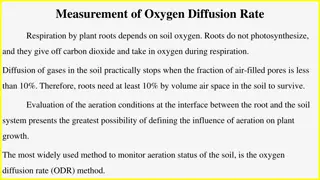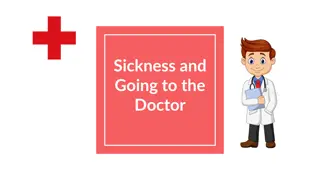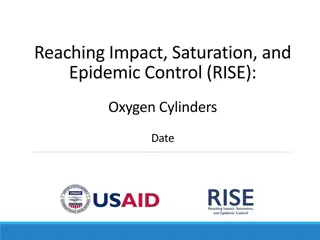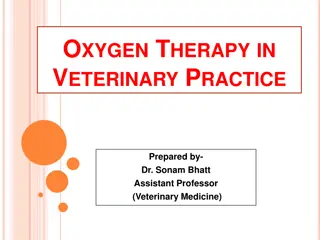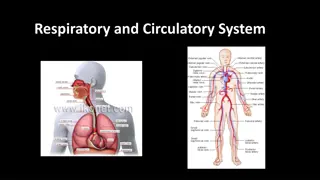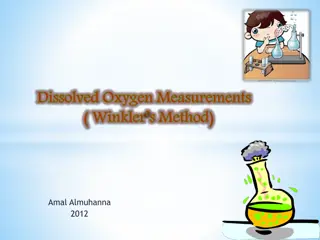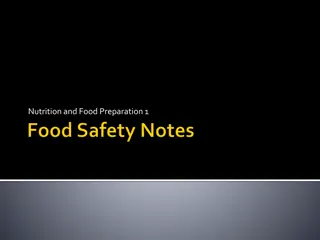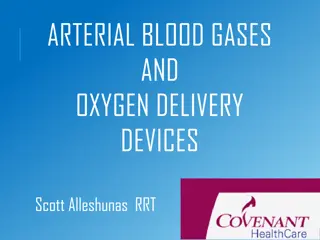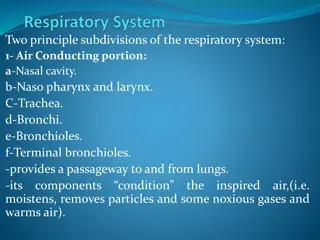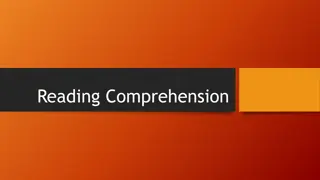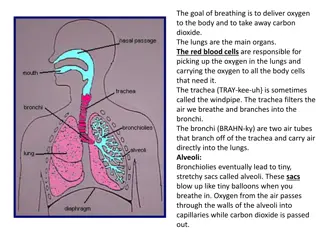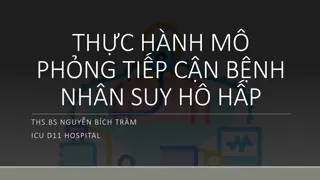Importance of Oxygen Therapy in Managing Respiratory Illnesses
Oxygen therapy is crucial in treating hypoxemia and saving lives, especially in patients with severe acute respiratory infections like COVID-19. This module covers the significance of oxygen therapy, indications for its use, methods to measure blood oxygen levels, and how to titrate oxygen therapy effectively. Effective oxygen delivery systems are emphasized to be a universal standard of care. Immediate administration of oxygen is emphasized for patients showing signs of severe illness, with specific SpO2 thresholds for different conditions. Higher flow rates are recommended for critically ill patients.
Download Presentation

Please find below an Image/Link to download the presentation.
The content on the website is provided AS IS for your information and personal use only. It may not be sold, licensed, or shared on other websites without obtaining consent from the author. Download presentation by click this link. If you encounter any issues during the download, it is possible that the publisher has removed the file from their server.
E N D
Presentation Transcript
OXYGEN THERAPY Module: Developed with input from MOH, WHO,CDC,IDI
Learning objectives At the end of this lecture, you will be able to: Describe importance of oxygen therapy. Recognize indications for oxygen therapy in Managing Acute Respiratory Infections (including those due to COVID-19) . Describe how to initiate oxygen therapy. Describe two different methods to measure blood oxygen levels. Explain how to titrate oxygen therapy. HEALTH EMERGENCIES programme
Importance of oxygen therapy Hypoxaemia is a life-threatening condition that can be easily treated with oxygen therapy: - oxygen therapy saves lives. Oxygen therapy is an essential medicine that should be available in all areas that may care for SARI patients. Oxygen therapy is cost-effective. Oxygen therapy is safe in newborns (preterm and term) that are hypoxic. HEALTH EMERGENCIES programme
Importance of oxygen thearpy Effective oxygen delivery systems should be a universal standard of care and should be made more widely available. (WHO, 2016) HEALTH EMERGENCIES programme
Oxygen: indications 1/2 In the hospital setting, give oxygen immediately to patients (adults and children) with SARI who have signs of severe illness: severe respiratory distress sepsis with hypoperfusion or shock alteration of mental status or hypoxaemia SpO2 < 90% (if patient is haemodynamically normal) SpO2 < 94% (if patient with any emergency signs of airway, breathing or circulation) SpO2< 92 95% (if pregnant woman). Do NOT delay oxygen administration. HEALTH EMERGENCIES programme
Oxygen: indications 2/2 In children, clinical signs that should trigger oxygen therapy include (when pulse oximeter not available): central cyanosis nasal flaring inability to drink or feed (when due to respiratory distress) grunting with every breath depressed mental state (i.e. drowsy, lethargic) and in certain conditions (severe lower chest indrawing, RR 70 bpm, head nodding). Do NOT delay oxygen administration.
If patient is critically ill, give higher flow rates In adults and older children, start with 10 15 l/min via face mask with reservoir bag. Less ill patients can start with 5 L/min by nasal cannula. HEALTH EMERGENCIES programme
In children < 5 years, preference is nasal cannula Age of child Neonates Infants Pre-school aged School-aged Maximal oxygen flow rates 0.5 1.0 L/min by nasal cannula 1 2 L/min by nasal cannula 1 4 L/min by nasal cannula 1 6 L/min by nasal cannula If severe hypoxaemia persists despite maximal flow rates: start CPAP (if available) start secondary source of oxygen with face mask with reservoir bag insert nasopharyngeal catheter (passed uvula into the pharynx) and give oxygen at flow rates: neonates 0.5 L/min; infants 1 L/min. HEALTH EMERGENCIES programme
Nasopharyngeal catheter For severe hypoxaemia: place passed uvula into the pharynx provides higher oxygen levels at similar flow rates because of PEEP needs to be humidified neonates, dose is 0.5 L/min infants, dose is 1 L/min use with nasogastric tube. HEALTH EMERGENCIES programme
Oxygen therapy in children Compliance may require assistance from nursing staff and family members. Humidification is not required when using standard flow rates, as natural nasal mechanisms heat and humidify. FiO2 is determined by flow rate, nasal diameter and body weight: in infants up to 10 kg: 0.5 L/min (35%); 1 L/min (45%); 2 L/min (55%). HEALTH EMERGENCIES programme
Monitor oxygen levels Clinical signs are not reliable indicators of hypoxaemia. Pulse oximeters should be available in all settings caring for patients with SARI and used to measure the SpO2 - pre-hospital, emergency area, ward, and ICU. Blood gas analyser should be available in the ICU: measures pH, PO2, and PCO2 for patients on mechanical ventilation, with severe hypoxaemia, risk of hypercapnea and shock states. HEALTH EMERGENCIES programme
Oxygen titration to reach target Titrate oxygen to target: SpO2 90% in adults and children SpO2 92 95% in pregnantpatients SpO2 94% if child or adult with signs of multi-organ failure, including shock, alteration of mental status, severe anaemia until resuscitation has stabilized patients, then resume target 90%. Titrate oxygen up and down to achieve target. Wean oxygen when patient is stable. HEALTH EMERGENCIES programme
Titrate oxygen: use appropriate dose and delivery device Medical Illustration, Leicester Royal Infirmary, Leicester,UK Make sure bag is full O2 dose 1 5L/min O2 dose 6 10L/min O2 dose 10 15L/min FiO2 estimate 0.25 0.40 FiO2 estimate 0.60 0.95 FiO2 estimate0.40 0.60 Nasal cannula Simple face mask Face mask with reservoir bag HEALTH EMERGENCIES programme
IPC and oxygen therapy Ensure single patient use of nasal prongs, simple face masks and face masks with reservoir bag to prevent nosocomial infection. Humidification is not necessary when delivering low flow rates. The oropharynx and nasopharynx provide sufficient humidity. - In children, flow rates are considered high when > 2 L/kg/min. Avoid bubble bottles because of risk of infection. HEALTH EMERGENCIES programme
Recognize acute hypoxaemic respiratory failure Patients not responding to increasing oxygen therapy are developing acute hypoxaemic respiratory failure: signs of severe respiratory distress hypoxaemia (SpO2 < 90%) despite escalating oxygen therapy SpO2/FiO2 < 300 while on at least 10 L/min oxygen therapy Cardiogenic pulmonary oedema not primary cause. HEALTH EMERGENCIES programme
High-flow oxygen system for acute hypoxemic respiratory failure High-flow oxygen systems can be used for adults and children: Selected patient must be awake, cooperative, haemodynamically stable without urgent need for intubation. May generate aerosols so should be used with airborne precautions. HEALTH EMERGENCIES programme
High-flow oxygen system Comfortable nasal cannula interface. Reliably titrates FiO2 up to 100%. Humidification prevents dryness. In adults, delivers flow rates as high as 60 L/min. In infants and young children, maximum flow rates are less, based on age and weight: i.e. 2 L/kg/min up to maximum of 60 L/min HEALTH EMERGENCIES programme
High-flow oxygen therapy Aims to match patient s inspiratory demand. Reduces work of breathing. Washes out nasopharyngeal dead space. Provides low level of PEEP. May induce less injury to the lung in ARDS. Monitor closely for need for intubation. HEALTH EMERGENCIES programme
Tips: about oxygen use Appropriate use of oxygen will optimize quality care and minimizes waste. When using traditional nasal cannula and face mask, increasing flow rates does not reliably deliver higher oxygen concentrations (FiO2), because patients also breathes in room air, which dilutes oxygen making exact FiO2variable. HEALTH EMERGENCIES programme
Useful website http://www.who.int/patientsafety/safesurgery/pulse_oximetry/tr_material/en/ HEALTH EMERGENCIES programme
Summary Give oxygen immediately to patients with SARI with severe respiratory distress, sepsis with hypoperfusion/shock or hypoxaemia, SpO2<90%. In critically ill adults and children start with highest flow rate available and appropriate for age. Pulse oximeters should be available in all areas where emergency oxygen is delivered. Blood gas analyzer should be available in the ICU to also measure ventilatory parameters (pH, PaCo2) Titrate oxygen to target SpO2 90% in adults and children, > 92-95% in pregnant females, or 94% during resuscitation of patient with multi-organ failure using the appropriate dose (flow rate) and delivery device. Newer high flow oxygen systems can be used in select cases of non- hypercapneic, hypoxemic respiratory failure. HEALTH EMERGENCIES programme
Acknowledgements Contributors Dr T Eoin West, University of Washington, Seattle, USA Dr Janet V Diaz, WHO Consultant, San Francisco, USA Dr Arjun Karki, Patan Academy of Health Sciences, Kathmandu, Nepal Dr Niranjan Bhat, Johns Hopkins University, Baltimore, USA Dr Timothy Uyeki, Centers for Disease Control and Prevention, Atlanta, USA Dr Simon Mardel, University Hospital of South Manchester NHS Foundation Trust Dr Paula Lister, Great Ormond Street Hospital, London, UK Dr Neill Adhikari, Sunnybrook Health Sciences Centre, Toronto, Canada Dr Andy Petros, Great Ormond Street Hospital, London, UK HEALTH EMERGENCIES programme











